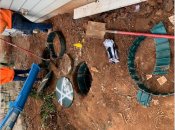Abandonment of a Septic System
Tank abandonment requires an over-the-counter septic permit that is issued the same day. See application below. Please provide a scaled plot plan with an accurate location of the tank(s) to be abandoned indicating the manner in which it is to be abandoned. Call to make an appointment for inspection.
Several reasons an owner shall abandon a septic system:
- In the event the old tank fails, is no longer operational and is being replaced with a new tank in a new location.
- The system has been operated in violation of the onsite manual regulations, unless and until a repair permit and an Operating Permit are subsequently issued.
- The system has been constructed, installed, altered or repaired without a required permit authorizing such, unless and until a permit is subsequently issued.
- A public sewer system becomes available to a building and the building sewer has been connected thereto; or
- The source of wastewater has been eliminated permanently.
Septic Tank Abandonment
Various factors determine what will happen to the old tank when it is no longer being used:
- Concrete septic tanks - pumped & filled with 2-sac slurry. If abandoning with dirt or pea gravel = must pump & break holes into the bottom of the tank prior to filling.
- Plastic or fiberglass septic tanks - may be removed and remaining hole filled in with dirt or they can be crushed and buried in place.
- Steel septic tanks - are either removed or crushed and buried in place.
Required steps for proper abandonment
- Locate all un-used septic tanks on the property. Some properties may have multiple systems that may not have been all properly documented. A septic contractor can assist in these steps and may have special equipment that can speed up the process.
- Pump out the septic tank - a septic contractor performs this step. Please see attached list of local septic contractors below. Must produce pumping receipt at time of inspection.
- Break open the septic tank bottom - this step is important to prevent accumulation of surface runoff which can result in an un-wanted water or mud reservoir. Take pictures. Call for inspection prior to filling.
- Fill in the septic tank or hole where the tank was located with dirt, gravel or 2-sac slurry so that there is no future collapse hazard. If the old tank was completely removed, the existing tank hole can be used to drop in a new tank in the same location. This may simplify plumbing connections to the new septic tank.
- Assure the septic tank fill is solid & compacted - otherwise future settlement of the septic tank fill can cause sudden dangerous collapses.
- Document the location of the abandoned tank(s) - so that future site work or building plans can be aware of their location and plan accordingly.

